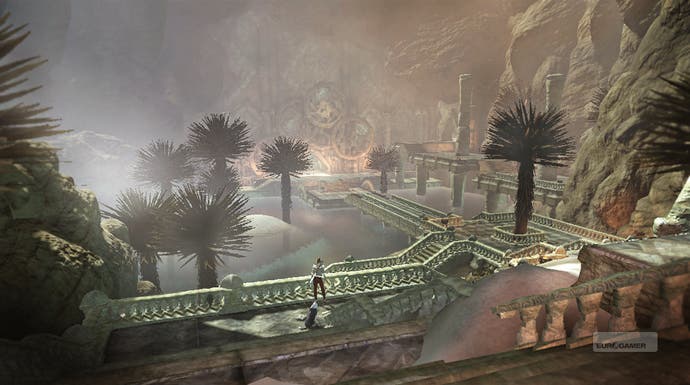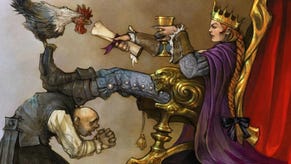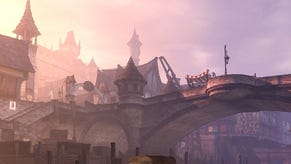Fable III
Rule of fun.
Wander close to any other character and a prompt pops up inviting you to press the left trigger to hold hands. This is the "touch" mechanic Molyneux is so proud of, allowing you to physically lead characters around in a style reminiscent of the PS2 classic ICO. I don't find a use for it beyond dragging a comely wench round the back of a barn and flirting with her, but that seems use enough, to be honest.
Later, Timmins and Eckersley show me "touch" working in a more structured story setting, at the end of the Shadelight Dungeon episode. The hero needs to lead her blinded companion Sir Walter out of the cave, dragging the slow old man by the hand, the animation noticeably different to my exploits as a rustic sexual pest. Timmins explains how something as simple as letting go of that left trigger at this point could make a profound change to your game.
"This is a completely subtle choice. At any point, we can let him go and run off. We don't say you have to go back, we never make it an objective or anything like that. Just cross the desert and leave him... If you were playing the retail game, he'd remember what you just did. There's ramifications."
Otherwise, back in Brightwall, everything has been freshened up considerably - with the exception of one creature and some of the hero models, Fable III's artwork is 100 per cent new - and the game feels more seamless and effortless to play, but also distinctly familiar. Your dog gambols around your feet and helps locate quest objectives, and the sparkling breadcrumb trail is there to tempt you towards something to do next, if you want it.

I end up dressing up in a chicken suit to bring some hens home to roost, and subsequently get involved in an animal rights debate with the farmer and his wife about whether to slaughter them. Then a local worthy asks me to help him get a divorce by seducing his uptight wife (in a scene revealing that the hero has a voice in dialogue this time around). If you were worrying about Fable losing its lightness of touch and sense of humour as it goes all political, don't.
One remarkable change is the game's menu interface. Incredibly for a role-playing game, there isn't one. Press start and, in a neat bit of technical sleight-of-hand, you're instantly warped to your Sanctuary, an otherworldly home, map and options interface in one. Here you'll find your John Cleese-voiced butler Jasper who offers explanation, guidance and dry comment. (Fable III's impressive voice cast also includes Bernard Hill, Simon Pegg, Michael Fassbender, Zoe Wannamaker, Jonathan Ross and Stephen Fry.)

You change your weaponry, wardrobe and other options in this dark chamber by walking through a series of doors, and there's a 3D map table in the centre to interact with. You can use it to see all open quests and warp to them. A treasury room houses your records and stats, and a Live room leads to the game's online co-operative mode for two.
This, as we've heard before, is much improved over Fable II's. "We do admit, the co-op in Fable II was rubbish," says Timmins frankly. "We'd be restricted to being within 10 yards of each other, I'd have to be your henchman. What we've done this time is, if you bring your hero into my game, you bring your hero, your stats, your weapons, your interface... Together we can run anywhere in the same region." You'll be able to pursue entirely different tasks as you go, as well as trade weapons, even get married.








